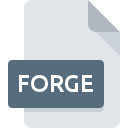.FORGE File Extension

Ubisoft Game Data File
| Developer | Ubisoft |
| Popularity | |
| Category | Game Files |
| Format | .FORGE |
| Cross Platform | Update Soon |
What is an FORGE file?
.FORGE files are proprietary file formats developed by Ubisoft, a leading global developer and publisher of video games.
These files are primarily utilized to store a wide array of game-related data, including but not limited to graphics, audio, video, scripts, and other resources essential for the operation of Ubisoft games.
More Information.
Ubisoft introduced the .FORGE file extension as part of its proprietary game development ecosystem. Initially, these files were primarily used internally by Ubisoft’s development teams to compile and package game assets efficiently.
As Ubisoft expanded its portfolio and released games to the public, the .FORGE format became instrumental in delivering optimized gaming experiences across various platforms.
Origin Of This File.
The .FORGE file extension can be traced back to Ubisoft’s need for a robust and efficient method of organizing and storing game assets.
As game development evolved and became more complex, the necessity for a standardized file format capable of accommodating diverse types of data arose.
Consequently, Ubisoft engineers devised the .FORGE format to streamline the storage and retrieval of game assets, thereby optimizing the development process and enhancing the overall gaming experience.
File Structure Technical Specification.
.FORGE files exhibit a structured layout designed to accommodate different types of game assets while maintaining efficiency and performance.
Although the specific structure may vary depending on the game and its requirements, a typical .FORGE file comprises several sections, each dedicated to specific types of data such as textures, models, audio files, scripts, and more.
These sections are organized hierarchically, allowing for easy navigation and retrieval of assets during runtime.
At a technical level, .FORGE files may employ compression techniques to reduce storage requirements and optimize data retrieval speed.
Additionally, they may incorporate encryption algorithms to safeguard sensitive assets from unauthorized access or tampering.
How to Convert the File?
Converting .FORGE files to alternative formats entail a nuanced approach, considering the complex interdependencies of game assets contained within.
While specialized software tools may offer conversion capabilities, the process often involves extracting individual elements from the .FORGE archive and transforming them into compatible formats as needed.
For instance, textures and models within a .FORGE files may be extracted and converted to standard image and 3D model formats, respectively, using dedicated utilities.
Similarly, audio files can be extracted and transcoded into widely supported formats for playback or editing purposes.
Advantages And Disadvantages.
The utilization of .FORGE files offer several advantages for game developers and players alike.
By consolidating diverse assets into a single container, these files simplify the game deployment process, reducing overhead and enhancing efficiency.
Moreover, the inherent compression techniques employed within .FORGE files optimize storage space without compromising on data integrity or performance.
The proprietary nature of .FORGE files may pose challenges for modders and enthusiasts seeking to modify or extend game content.
Reverse-engineering these files to extract or manipulate their contents requires specialized knowledge and tools, limiting accessibility for casual users.
How to Open FORGE?
Open In Windows
- Ubisoft’s Official Tools: Ubisoft provides proprietary tools for handling .FORGE files on Windows. These tools, often bundled with game development kits or modding utilities, offer comprehensive functionality for extracting, viewing, and modifying game assets stored within .FORGE archives.
- Third-Party Utilities: Several third-party utilities cater to the Windows platform, offering alternative means of accessing .FORGE files. Examples include Gibbed’s RED Tools and QuickBMS, which provide command-line interfaces for extracting and manipulating the contents of .FORGE archives.
Open In Linux
- Wine Compatibility Layer: Linux users can leverage Wine, a compatibility layer capable of running Windows applications, to access Ubisoft’s official tools for handling .FORGE files. By installing Wine and configuring it to support the required dependencies, Linux users can execute Windows-based utilities seamlessly.
- Community-Developed Tools: The vibrant Linux community often produces open-source alternatives to proprietary software. While not specifically tailored for .FORGE file management, these tools may offer functionalities for handling archive formats or binary data, which can be adapted for working with .FORGE files.
Open In MAC
- Wine Compatibility Layer: Similar to Linux, macOS users can employ Wine to run Windows applications that support .FORGE file manipulation. By installing Wine alongside the necessary libraries and dependencies, macOS users can access Ubisoft’s official tools or community-developed alternatives for working with .FORGE files.
- Virtual Machines: Another approach for macOS users involves running a virtual machine (VM) with a Windows guest operating system. By installing Windows within a VM environment, users can execute Windows-based utilities for handling .FORGE files seamlessly, albeit with potentially higher resource overhead.
Open In Android
- Third-Party Apps: While .FORGE file management on Android devices is less common compared to traditional computing platforms, third-party file manager apps available on the Google Play Store may offer limited support for handling archive formats, including .FORGE files. However, functionality may be restricted, and compatibility issues may arise.
- Custom Scripts or Apps: Advanced users with programming knowledge may develop custom scripts or apps tailored for .FORGE file manipulation on Android devices. By leveraging programming languages such as Python or Java, developers can create specialized tools capable of extracting, viewing, or modifying .FORGE archives directly on Android.
Open In IOS
- Limited Options: Due to the closed nature of the iOS ecosystem, options for directly opening .FORGE files on iOS devices are limited. Users may explore file management apps available on the App Store, but support for specialized file formats like .FORGE is typically scarce.
- Remote Access: An alternative approach involves accessing .FORGE files stored on remote servers or cloud storage platforms using iOS-compatible file management apps. By leveraging network connectivity and remote access protocols, users can manipulate .FORGE files indirectly from their iOS devices, albeit with potential limitations in functionality and performance.













